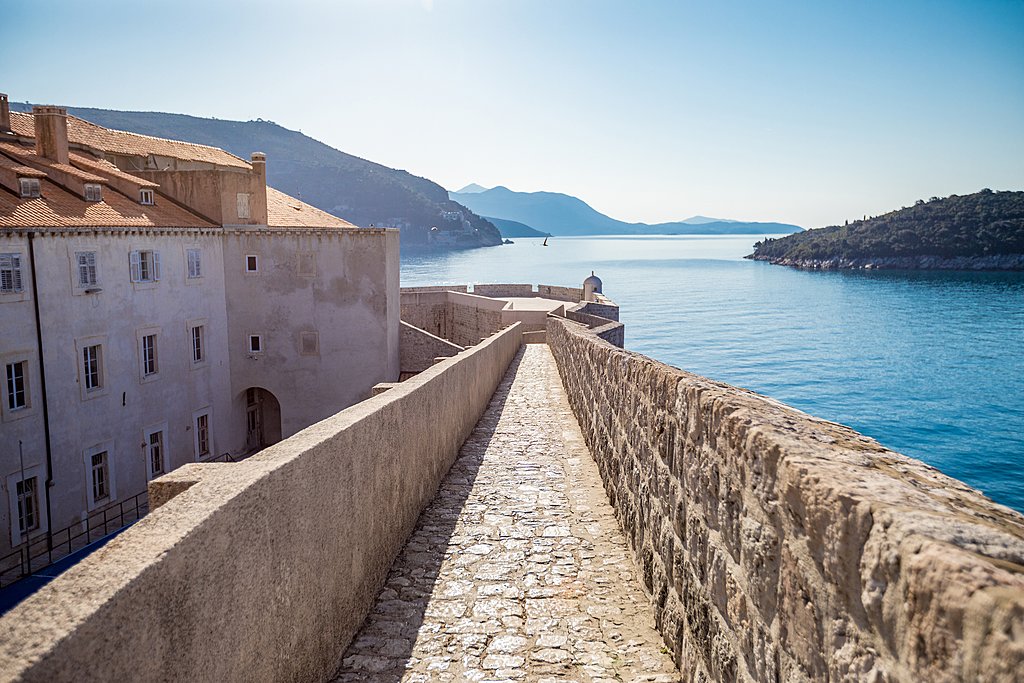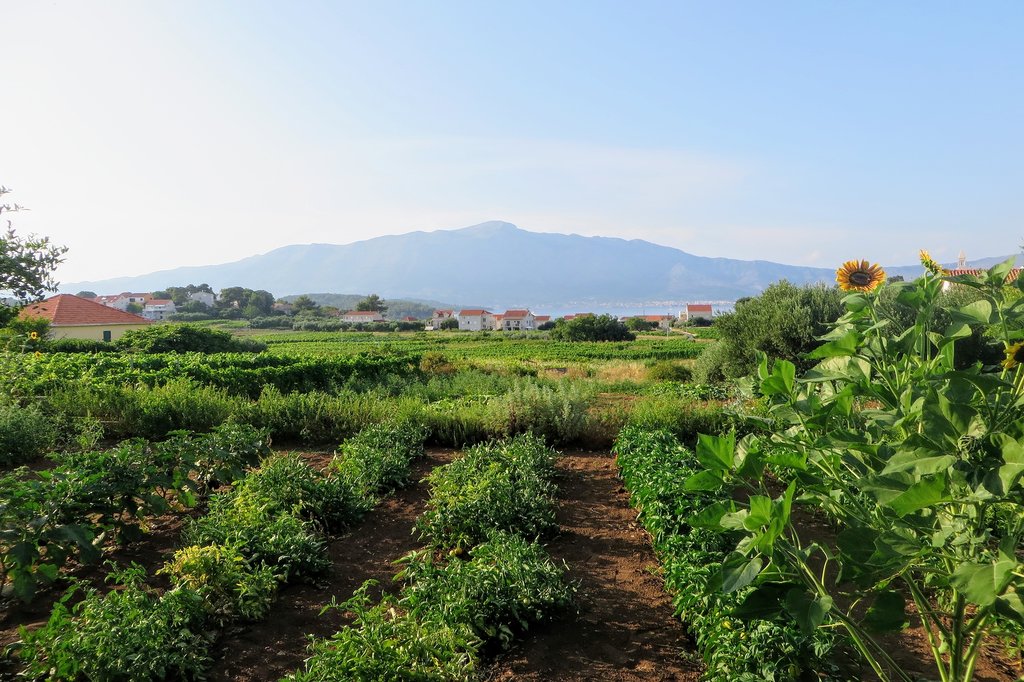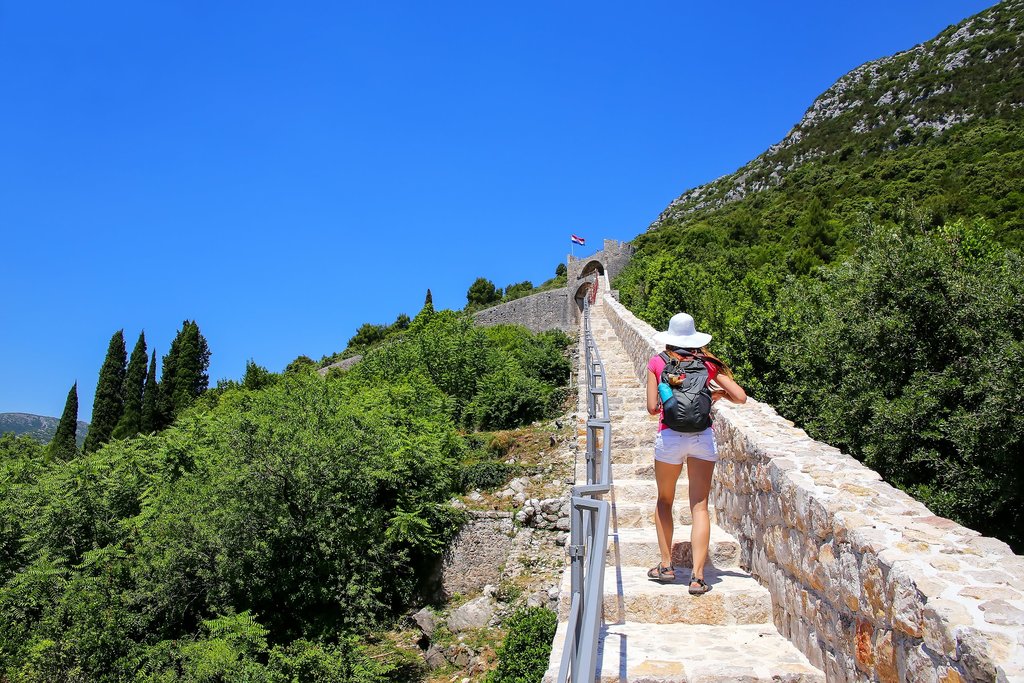Highlights
- Watch a Dalmatian sunset over the sparkling Adriatic from atop Srđ Mountain
- Paddle to and snorkel the hidden Green Cave on Šipan
- Cycle through Lumbarda wine country and taste native Grk wine
- Discover the raw beauty of the Pelješac peninsula
- Swim, hike, or ride the lush landscapes of Mljet Island's national Park
Brief Itinerary
| Day | Highlights | Overnight |
|---|---|---|
| Day 1 | Welcome to Dubrovnik! | Dubrovnik |
| Day 2 | Elafiti Islands by Private Speedboat: Kayaking, Swimming, & Villages | Dubrovnik |
| Day 3 | Ferry from Dubrovnik to Korčula | Korčula Town |
| Day 4 | Cycling & Wine Tasting Tour in Lumbarda | Korčula Town |
| Day 5 | Korčula to Ston via Pelješac Peninsula | Ston |
| Day 6 | Day Trip to Mljet National Park from Ston | Ston |
| Day 7 | Explore Ston, Drive to Dubrovnik | Dubrovnik |
| Day 8 | Depart Dubrovnik |
Detailed Itinerary
Day 1: Welcome to Dubrovnik!

This is a treat because you'll be arriving in one of the most ancient fortress cities in Europe. Known as the "Adriatic Pearl," Dubrovnik is a piece of history. While there's evidence of settlements as far back as the Byzantine era, this area only came into its own in the 12th and 13th centuries when it was under the rule of the Venetians. Throughout the middle ages, it was a fortress port encircled by stone walls and filled with baroque churches and renaissance/gothic palaces that still stand today.
Upon arrival at the airport, you'll transfer to your hotel for check-in. Despite being tired from the journey, you'll likely want to get out and explore. Can't-miss activities include riding the cable car up to Srđ Mountain to take in the sunset over the nearby Elafiti Islands, visiting Lovrijenac and Bokar fortresses, and walking along the smooth, limestone-paved streets of historic Old Town.
After spending some time getting to know the city, duck into one of Dubrovnik's many wine bars to relax. It's a good plan, as there's no better manner in which to celebrate your first day in Croatia than by enjoying a glass of white or red wine as the sun goes down over Dubrovnik's Old Town. For dinner, there are a number of great restaurants you can choose from.
Day 2: Elafiti Islands by Private Speedboat: Kayaking, Swimming, & Villages

Today you'll set out on an exciting day trip to discover the vegetation-covered Elafiti Islands. Set between Dubrovnik and the Pelješac peninsula to the north, the small archipelago consists of 13 lush islands where only Koločep, Šipan, and Lopud are presently inhabited. Meet your skipper at Dubrovnik's Gruž harbor and board your private speedboat to cruise to the nearby island of Lopud.
You'll then switch into your sea-kayak after a brief introductory lesson and together with your snorkeling gear, paddle across the channel to the hidden Green Cave on Šipan. Tie up your kayak outside the mouth of the sandy-bottom cave to spend time snorkeling and exploring your surroundings. And if you're up for it, the spot is perfect for a little cliff jumping as well. After a full day of paddling, swimming, and visiting island villages, you'll return to Dubrovnik.
Day 3: Ferry from Dubrovnik to Korčula

Catch a two-hour ferry from Dubrovnik to Korčula in the morning. The afternoon and evening are yours to discover this little island's numerous restaurants, taverns, shops, and bars as you roam the maze of gray stone houses, alleys, churches, and squares.
Enjoy a traditional lunch of lamb and goat in Korčula's Old Town, one of the finest examples of Venetian architecture on the Dalmatian coast. Next, visit the 14th-century Land Gate on top of an elegant staircase, before heading to the St. Mark's Cathedral to admire its strange sculptures of beasts and people. Art enthusiasts will appreciate a visit to the Bishop's Treasury next door for a small but impressive art collection, including works from Carpaccio, Bassano, and Tiepolo. From there, you may wish to visit the unremarkable house thought to be the birthplace of Marco Polo.
If beaches are what you're after, rent a bike or ride the bus the 5 miles (8 km) to the sandy beaches of Lumbarda. Afterward, grab a bite to eat and pair it with the local dry white, Grk, indigenous to Lumbarda and nowhere else.
Chat with a local specialist who can help organize your trip.
Day 4: Cycling & Wine Tasting Tour in Lumbarda

Spend the day on a cycling tour (private or with a group) across the island from Korčula Town to Lumbarda with stops along the way to visit beaches and wineries. Pick up your bike and meet your guide in Korčula and ride out of the town south toward Lumbarda. You will cycle through fields, villages, and wineries, covering asphalt, gravel, and dirt roads with vistas opening up to the Adriatic Sea as well as to the impressive Mt. Ilija on the nearby Pelješac Peninsula.
This gentle route explores the ancient and historical sites of the eastern side of the island as you work your way to the spread-out village of Lumbarda. Boasting beautiful beaches and centuries-old winemaking traditions, Lumbarda is home to Grk, a white grape variety that will pair well with your lunch or dinner. Some of Croatia's best white wines are produced on Korčula and you won't be left wanting.
You'll also have the opportunity to visit Bire Winery, a family-run winery that produces Grk wine as well as its own varietals, including a rosé. All the wineries in the area produce Grk which is unique to this region due to its sandy soil and Plavac Mali (a red grape grown extensively across South Dalmatia that acts as a pollinator for the Grk vines).
Take some time to relax on one of Lumbarda's beaches before returning to Korčula Town for the evening.
Cycling time: 3-5 hours
Day 5: Korčula to Ston via Pelješac Peninsula

Make your way to the ferry terminal in either Korčula Old Town (foot passengers) or nearby Dominče (car ferries) to transfer the short distance to Orebić on the Pelješac Peninsula. Wander the seaside town's narrow streets, noting the charming stone villas once occupied by famous sea captains. From here, you'll continue your journey southeast to your hotel in the medieval city of Ston, stopping to sample Dingač, Croatia's most well-known red at any of the numerous vineyards populating the rugged landscape.
If there's interest, rent a bike and cycle along the Plavac Mali vineyards to a quiet bay for a swim, snorkel, and lunch break before carrying on to Ston, twin settlement to Mali Ston on the opposite end of the peninsula's isthmus. End the day with a meal of Ston's famous fresh oysters or mussels accompanied by a glass of local Dingač.
Ferry time (Korčula to Orebić): 30 minutes
Driving time (Orebić to Ston): 1 hour
Day 6: Day Trip to Mljet National Park from Ston

Mljet Island is considered the greenest Croatian island and is home to Mljet National Park, which covers a third of the island. Its longtime isolation has kept it sheltered from the impacts of tourism. What once seemed to be a disadvantage for the island has turned into one of its most important and advantageous features.
On the island, you can take a guided tour through the national park and visit a 12th-century Benedictine monastery, before exploring the island on your own. You can hire bikes to go around two beautiful salt-water lakes, Veliko and Malo Jezero, which are surrounded by dense pine forests. And if the mood should strike, there's always the option to stop for a swim in the lakes (which are invariably warmer than the open Adriatic sea!). Then, grab lunch at a local restaurant.
Depending on your schedule, you can see more of the island which is great for cycling, renting a kayak, or simply exploring the lakes.
Day 7: Explore Ston, Drive to Dubrovnik

Take the better part of the day to explore Ston, its surroundings, and of course its impressive fortified walls—the longest on the continent (originally built to keep predators away from the town's saltpans) and discover the importance this area held in the 14th century. Enjoy beautiful views over the Adriatic and Ston and its glittering saltpans—one of the oldest and still active in the Mediterranean—from a parapet walkway.
Rent a kayak and paddle amid oyster and mussel farms in Ston's bay, taking in the striking views of the walls from the sea. Alternatively, if you're looking for more of a beach day, find your way to Prapratno, just over a mile away for access to the peninsula's largest sandy beach.
When it's time, make your way to your accommodation in the historic coastal fortress city of Dubrovnik. The remainder of the day will be at your leisure, allowing time for you to wander and explore this magical city. Climb the 16th-century city walls for incredible views of countless red rooftops of old stone houses, towers, turrets, churches, and palaces. And be sure to find your way to the limestone-paved Stradun, Dubrovnik's main street to get your bearings and choose from some of Croatia's best restaurants and wine bars.
Driving time (Ston to Dubrovnik): 1 hour
Day 8: Depart Dubrovnik

Depending on when you depart, you may have time to visit one of Dubrovnik's museums, like the Franciscan Monastery and Museum. This large complex houses many treasures, including the world's third oldest pharmacy dating from 1317.
Alternatively, for a collection of 15,000 pieces of interesting works, visit the Rector's Palace and Cultural Historical Museum. Wander this well-preserved palace-turned-museum and explore its exhibits, some detailing life in the Republic of Ragusa during medieval times.
The drive to the airport from Dubrovnik takes around 45 minutes with normal traffic.
